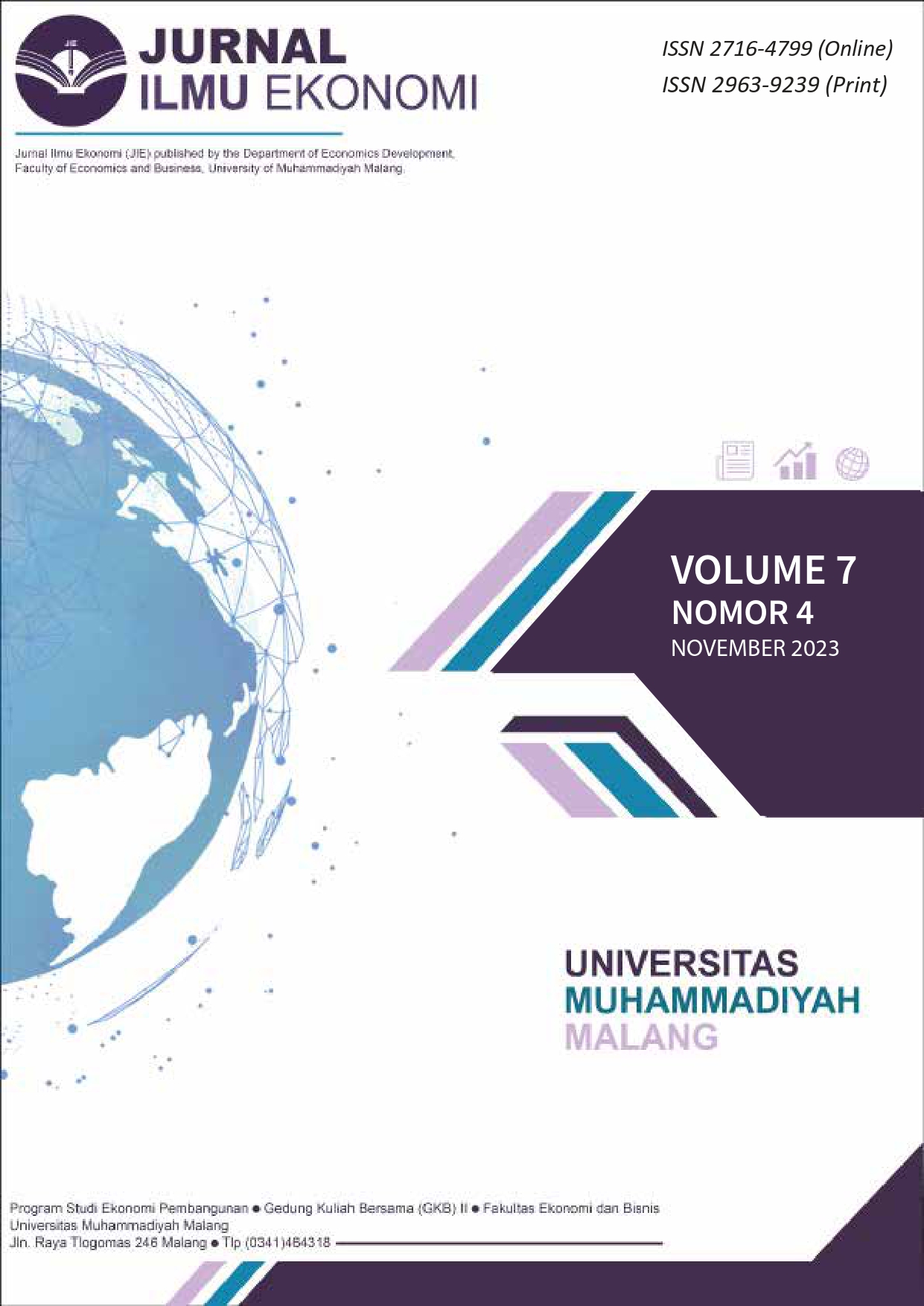Identifikasi Pusat Pertumbuhan Ekonomi pada Tingkat Kabupaten di Provinsi Kalimantan Selatan
DOI:
https://doi.org/10.22219/jie.v7i04.27061Keywords:
Scalogram Analysis, Gravity Model, Klassen TypologyAbstract
Determining the center of economic growth is one of the government's regional development strategies to address inequality between regions, conditions in each region are different. The purpose of this research is to identify the center of economic growth in South Kalimantan Province, the analytical tools used are scalogram analysis, gravity analysis and Klassen typology. The data used in the scalographic analysis are social, economic and government facilities, the types of these facilities include data on social facilities in the form of educational facilities, health facilities and worship facilities. For data on economic facilities in the form of: markets, means of transportation (public transportation), small industries, stations and lodging, savings and loan cooperatives, KUD cooperatives. Government facilities in the form of: village office, sub-district office. The results show that the center of growth for South Kalimantan Province is Banjarmasin City and has close interactions with Banjar Regency, Banjarbaru City and Barito Kuala Regency as hinterland areas, Banjarmasin City is in quadrant two which is one of the developed but depressed areas.
Penentuan pusat pertumbuhan ekonomi ini salah satu strategi pengembangan wilayah yang dilakukan pemerintah untuk menangani ketimpangan antar wilayah, kondisi setiap daerah yang berbeda-beda. Tujuan penelitian ini untuk mengidentifikasi pusat pertumbuhan ekonomi di Provinsi Kalimantan Selatan, alat analisis yang digunakan adalah analysis scalogram, analisis gravitasi dan tipologi klassen. Data yang digunakan pada analisis skalogran yaitu fasilitas sosial, ekonomi dan pemerintahan, jenis-jenis fasilitas-fasilitas tersebut diantaranya meliputi data fasilitas sosial berupa fasilitas pendidikan, fasilitas kesehatan dan fasilitas peribadatan. Untuk data fasilitas ekonomi berupa: pasar, sarana angkutan (angkutan umum), industri kecil, stasiun dan penginapan, koperasi simpan pinjam, koperasi KUD. Fasilitas pemerintahan yang berupa: kantor Desa, kantor Kelurahan. Hasil menunnjukan bahwa pusat pertumbuhan Provinsi Kalimantan Selatan adalah Kota Banjarmasin dan memiliki interaksi yang erat dengan Kabupaten Banjar, Kota Banjarbaru dan Kabupaten Barito Kuala sebagai daerah hinterland, Kota Banjarmasin berada pada kuadran dua yang merupakan salah satu daerah daerah maju tapi tertekan.
Downloads
References
Darnilawati. (2018). Strategi Kutup Pertumbuhan Ekonomi. Jurnal Ekonomi, 6(1), 1–8. http://journals.sagepub.com/doi/10.1177/1120700020921110%0Ahttps://doi.org/10.1016/j.reuma.2018.06.001%0Ahttps://doi.org/10.1016/j.arth.2018.03.044%0Ahttps://reader.elsevier.com/reader/sd/pii/S1063458420300078?token=C039B8B13922A2079230DC9AF11A333E295FCD8
Emalia, Z., & Farida, I. (2018). Identifikasi Pusat Pertumbuhan Dan Interaksi Spasial Di Provinsi Lampung. Jurnal Ekonomi & Studi Pembangunan, 19(1), 61–74. https://doi.org/10.18196/jesp.19.1.4100
Ermawati. (2010). Analisis Pusat Pertumbuhan Ekonomi Pada Tingkat Kecamatan di Kabupaten Karanganyar Provinsi Jawa Tengah [Universitas Sebelas Maret Surakarta]. https://digilib.uns.ac.id/dokumen/download/12513/MjcwNjk=/Analisis-pusat-pertumbuhan-ekonomi-pada-tingkat-kecamatan-di-Kabupaten-Karanganyar-Provinsi-Jawa-Tengah-abstrak.pdf
Fudhail, I., Sambodo, H., & Purnomo, S. D. (2021). Identifikasi Pusat Pertumbuhan dan Analisis Interaksi Spasial Perekonomian di Provinsi Jawa Timur. J-MAS (Jurnal Manajemen Dan Sains), 6(1), 43–52. https://doi.org/10.33087/jmas.v6i1.217
Gulo, Y. (2015). Growth Center Identification and Its Supporting Area in Nias Regency Regional Development. Jurnal Widyariset, 18(1), 37–48. https://core.ac.uk/download/pdf/304736659.pdf
Halwan, S. M. (2022). Analisis Penentuan Desa Pusat Pertumbuhan di Kecamatan Parongpong Kabupaten Bandung Barat. Unstitut Teknologi Nasional Bandung.
Hariyanti, E. (2022). Identifikasi Pusat Pertumbuhan dan Sektor Ekonomi Unggulan di Kawasan Wanarakuti. Geodika: Jurnal Kajian Ilmu Dan Pendidikan Geografi, 6(1), 1–12. https://doi.org/10.29408/geodika.v6i1.4362
Irfanti, P. E. (2019). Analisis Penentuan Pusat Pertumbuhan Dan Wilayah Hinterland Dalam Pengembangan Provinsi Jawa Timur. Universitas Jember.
Karmila, & Rabiana Risma, O. (2022). Identifikasi Pusat-Pusat Pertumbuhan Ekonomi Dalam Pengembangan Wilayah Kabupaten Aceh Selatan. Jurnal Pendidikan Dan Konseling, 4(3), 1739–1745.
Lesatari, P., & Jafra, R. A. (2022). Identifikasi Pusat Pertumbuhan Dalam Pengembangan Wilayah di Kecamatan Kuantan Mudik. Jurnal Perencanaan, Sains, Teknologi Dan Komuter, 5(2), 145–153.
Nandya, A. (2016). Identifikasi Pusat Pertumbuhan dan Wilayah Hinterland di Kabupaten Sleman. In Jurnal dspace UII. Universitas Islam Indonesia.
Optari, L. K. (2021). Analisis Interaksi Spasial Terhadap Penentuan Pusat Pertumbuhan Pada Pengembangan Wilayah Kabupaten Asahan. Prosiding Seminar Nasional & Call for Paper STIE AAS, Vol. 4 No. 1, 512–521. https://prosiding.stie-aas.ac.id/index.php/prosenas/article/view/144
Sari, M. (2021). Kajian Pusat Pertumbuhan dan Wilayah Hinterland di Kabupaten Siak. Universitas Islam Riau.
Utama, A. W. Y. (2017). Identifikasi Pusat Pertumbuhan dan Wilayah Hinterland di Kabupaten Klaten. Universitas Islam Indonesia.
Utami, S. P. (2020). Identifikasi Pusat Pertumbuhan dan Wilayah Hinterland di Kabupaten Magetan. In file:///C:/Users/VERA/Downloads/ASKEP_AGREGAT_ANAK_and_REMAJA_PRINT.docx (Vol. 21, Issue 1). Universitas Islam Indonesia.
Downloads
Published
How to Cite
Issue
Section
License
Copyright (c) 2023 Saputra, M. D. & Hidayat, W.

This work is licensed under a Creative Commons Attribution-NonCommercial-ShareAlike 4.0 International License.
Authors who publish with this journal agree to the following terms:
- For all articles published in the JIE (Jurnal Ilmu Ekonomi), copyright is retained by the authors. Authors give permission to the publisher to announce the work with conditions. When the manuscript is accepted for publication, the authors agree to the automatic transfer of non-exclusive publishing rights to the publisher.
- Authors retain copyright and grant the journal right of first publication with the work simultaneously licensed under a Creative Commons Attribution-NonCommercial-ShareAlike 4.0 International License that allows others to share the work with an acknowledgement of the work's authorship and initial publication in this journal.
- Authors are able to enter into separate, additional contractual arrangements for the non-exclusive distribution of the journal's published version of the work (e.g., post it to an institutional repository or publish it in a book), with an acknowledgement of its initial publication in this journal.
- Authors are permitted and encouraged to post their work online (e.g., in institutional repositories or on their website) prior to and during the submission process, as it can lead to productive exchanges, as well as earlier and greater citation of published work (See The Effect of Open Access).
This is an open access article and licensed under a Creative Commons Attribution-NonCommercial-ShareAlike 4.0 International License








